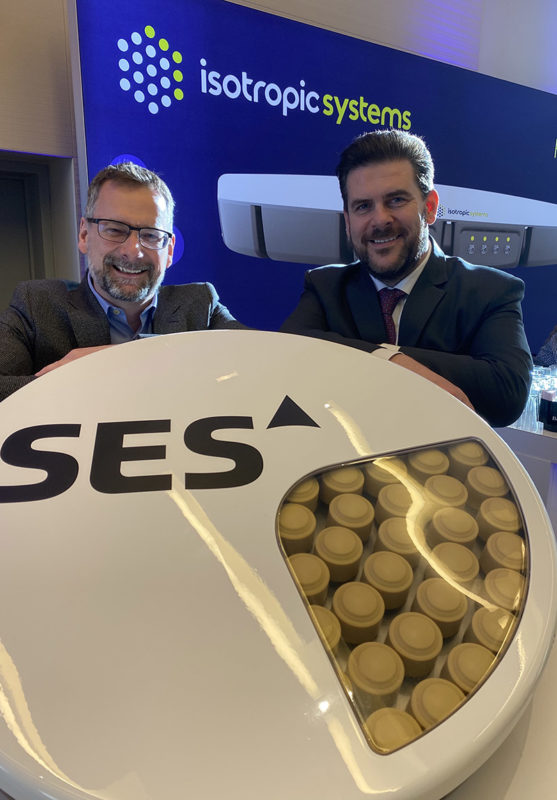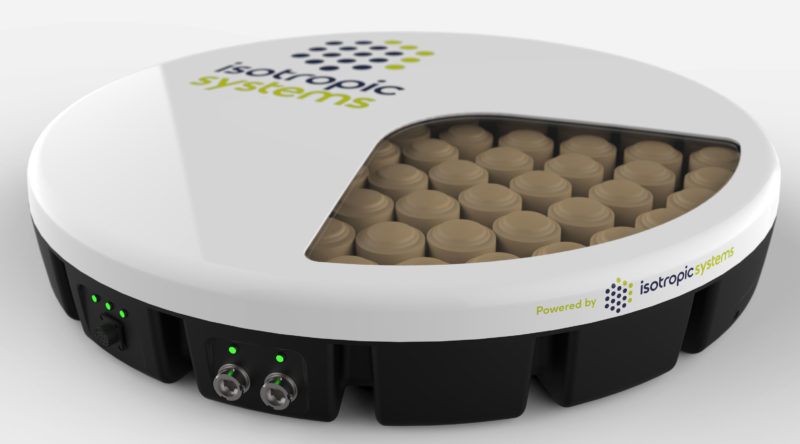Latest News

SES CEO Steve Collar and Isotropic Systems CEO John Finney with new terminal designed for SES O3b mPOWER. Photo: Isotropic Systems
This year, Isotropic Systems is in its final stage of collaboration with SES on software-defined, multi-beam customer edge terminal antennas compatible with O3b mPOWER — ahead of the commercial launch of the terminals with the O3b mPOWER Medium-Earth Orbit (MEO) system in 2022.
Isotropic CEO John Finney spoke to Via Satellite and said this is the result of years of work, and an example of Isotropic’s business strategy of partnering with major operators, such as SES and Inmarsat, and making technology that pairs with operators’ requirements.
“We have a full understanding of the major operator requirements to be effective in enterprise, and that’s how we developed the feature set for our first-generation product,” Finney said. “I think that over the course of time, this will be one of the key reasons why we’re able to distinguish ourselves from the competition, not just because we have really interesting technology that does new things, but those new things are designed to match what customers want.”
Throughout this year, Isotropic will test and optimize the tiered platform to meet specific performance, cost, power, and connectivity requirements of user cases. Previously in November 2019, Isotropic hit the performance milestone of demonstrating bi-directional high-speed connectivity with a Ka-band broadband satellite.
[Q&A With Isotropic Systems CEO on New Defense Innovation Unit Contract]
Finney said the first-generation terminal is in Ka-band in order to fulfill the needs of Non-Geostationary Orbit (NGSO) constellations. Isotropic has contracts with SES and Inmarsat, and understands Telesat’s requirements as well. Once the first-generation product in Ka-band is released, Isotropic plans to release a Ku-band version soon after. These terminals will be bi-directional, meaning that they can transmit and receive at the same time. In addition, when a second and third beam is added, Finney said, the antenna performance is multiplied, and there is no trade-off in performance. That capability, Finney said, is completely unique to Isotropic Systems’ terminal platform.

Isotropic Systems Ka-band terminal designed for SES. Photo: Isotropic
But beyond the first-generation terminals — Finney said Isotropic has the roadmap to a second-generation product: a converged antenna that operates in multiple frequencies and multiple beams.
“That means you can have complete arbitrage of everything that’s in the sky,” Finney said. “You can connect to a Ku-band satellite and a Ka-band satellite, and several of them at once — with complete discretion and control of the end user. And that’s considered something of the holy grail in this industry.”
That “holy grail” of antenna technology will be the result of years of development. Finney was a founding employee and CCO of O3b, and this is where he became passionate about the limitations of terminal infrastructure in terms of performance and reliability. He looked ahead to the coming age of mega-constellations of satellites, and realized that ground system technology would not match up.
“Over the course of the next 10 years, the amount of available options in space for connectivity will be vast, with anywhere between thousands of satellites, to tens of thousands of satellites, operating in different frequencies and different orbits,” Finney said. “You then have two choices. You either work with the legacy, old generation technology that was never designed for that future. … Or you innovate, to create something that’s purposely designed for the new world of satellites.”
This realization led Finney and Isotropic to apply the field of transformational optics — the manipulation of light to make objects appear invisible — to satellite antennas. Describing Isotropic’s deep tech, Finney said that light and radio propagate through space in the same way, in a straight line, so radio waves can be bent just like light waves. Using optical beam-forming technology, radio waves are shaped when passing through an Isotropic device, and no signal is lost. Finney said that this technology allows the company to provide its customers with much higher levels of bandwidth than any existing technology or emerging player.
“Ultimately, what we’re aiming to do is offer the entire ecosystem a set of capabilities that really are the closest possible match to the amazing performance that the satellite manufacturers are now putting into the sky,” he said.
Also in March, Isotropic announced that it is licensing patented core components of its multi-beam antennas to aeronautical and defense system integrators in order to accelerate customized designs, certifications, and deployments of next-generation terminals aboard commercial, business, and government aircraft.
Finney said the licensing approach is to avoid issues other companies encounter with getting certification onto aircraft.
Explaining the licensing strategy, Finney said: “We have to know that our modules are forming part of their next generation terminal story, such that we become a major component supplier to their finished next-gen aeronautical terminal. We’ll supply the lenses, the beam formers, the ASICs, the RFICs, and associated circuitry. And we will provide that under license. We will effectively be a component supplier to those integrators in those relationships, which I think will be more strategic by nature.”
Stay connected and get ahead with the leading source of industry intel!
Subscribe Now